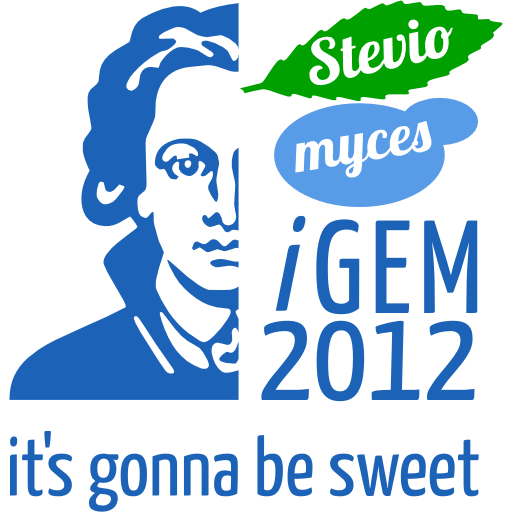Team:Frankfurt/Team
From 2012.igem.org
| Line 23: | Line 23: | ||
Of course we also enforced the answering of scientific questions during this time. An unsolved problem was the selection of an suitable organism. We were first favouring ''Escherichia coli'' for its easy handling and the fact that some teammembers were experienced with it as well as for being the most popular "iGEM-organism". However we expected to face inpregnable obstacles when using a Procaryote and so decided to use ''Saccharomyces cerevisiae'' for our trials, which brought us in contact with Prof. Boles who was also willing to act as our team instructor. With the help of Prof. Soppa, dean of studys at the faculty of biology, we were allowed to use the facilitys of the microbiological practical at the Institute of Molecular Biology for realising our idears. We gained financial support from a special subsidy fund of our university (''"Qualitätssicherung der Lehre"'' ~ Quality assurance of teaching) and are searching for further support from both business enterprises and scientific organisations and institutions. | Of course we also enforced the answering of scientific questions during this time. An unsolved problem was the selection of an suitable organism. We were first favouring ''Escherichia coli'' for its easy handling and the fact that some teammembers were experienced with it as well as for being the most popular "iGEM-organism". However we expected to face inpregnable obstacles when using a Procaryote and so decided to use ''Saccharomyces cerevisiae'' for our trials, which brought us in contact with Prof. Boles who was also willing to act as our team instructor. With the help of Prof. Soppa, dean of studys at the faculty of biology, we were allowed to use the facilitys of the microbiological practical at the Institute of Molecular Biology for realising our idears. We gained financial support from a special subsidy fund of our university (''"Qualitätssicherung der Lehre"'' ~ Quality assurance of teaching) and are searching for further support from both business enterprises and scientific organisations and institutions. | ||
| - | ==Team Members in Detail== | + | ==Student Team Members in Detail== |
| - | {| width="50%" align=" | + | {| width="50%" align="right" |
===Sebastian Roy=== | ===Sebastian Roy=== | ||
!align="center"|[[Image:Sebastian.png|100px|left]] | !align="center"|[[Image:Sebastian.png|100px|left]] | ||
|} | |} | ||
| - | {| width="50%" align=" | + | {| width="50%" align="left" |
===Charlotte Lorenz=== | ===Charlotte Lorenz=== | ||
| Line 35: | Line 35: | ||
|} | |} | ||
| - | {| width="50%" align=" | + | {| width="50%" align="right" |
===Christian Sachs=== | ===Christian Sachs=== | ||
!align="center"|[[Image:Teammember2Frankfurt.png|100px|left]] | !align="center"|[[Image:Teammember2Frankfurt.png|100px|left]] | ||
| + | |} | ||
| + | |||
| + | {| width="50%" align="left" | ||
| + | ===Leonard Fresenborg=== | ||
| + | !align="center"|[[Image:Leonard.png|100px|left]] | ||
|} | |} | ||
Revision as of 12:33, 13 September 2012
| Home | Team | Project | Organisms | Notebook | Registered Parts | Modeling | Safety | Attributions | Official Team Profile |
|---|
Contents |
Our Team
Evolution of the iGEM Team Frankfurt
Our Team startet to search for a suitable project for the iGEM 2012 competition in November 2011. First we screened former iGEM Wikis for interesting but incompleted ideas. Some of us informed themselves and presented the topics to the remainder of us for an open discussion. In parallel some presented their own ideas and gave small lectures about important methods in molecular biology, since the teammembers are from different scientific disciplines. In late November the topic of Stevia occurred both in the public media and in our team, because the trade and production of Steviol as a sweetener was going to be legalized by the European Comission. We investigated the scientific state of knowledge about the molecular background of Steviolglycoside bioynthesis and found that the genetic basis is on the one hand explored in its principles, on the other hand we noticed, that no publicated trials for a microbial production has been attemted so far. By this procedure, we ended up with three (?) ideas (beneath the Steviol subject those were the biotechnological explotation of autophagymechanisms and in vivo drug production) and finally decided to pursuit the mircobial Steviol production for this years iGEM competition.
We used the christmas holidays for a more specific literature research and began to contact several groupleaders and professors at our university to inform them about the existance of our team and ask for creative and professional assistance. If this was appreciated by the groups, we presented or project in their seminars. Now the question about the practical realisation became urgent. What we needed most was laboratory space, which emerged to be even more difficult than the need of financial support. We invested a lot of our time during February March in these two important reqirements for a participation in the competition.
Of course we also enforced the answering of scientific questions during this time. An unsolved problem was the selection of an suitable organism. We were first favouring Escherichia coli for its easy handling and the fact that some teammembers were experienced with it as well as for being the most popular "iGEM-organism". However we expected to face inpregnable obstacles when using a Procaryote and so decided to use Saccharomyces cerevisiae for our trials, which brought us in contact with Prof. Boles who was also willing to act as our team instructor. With the help of Prof. Soppa, dean of studys at the faculty of biology, we were allowed to use the facilitys of the microbiological practical at the Institute of Molecular Biology for realising our idears. We gained financial support from a special subsidy fund of our university ("Qualitätssicherung der Lehre" ~ Quality assurance of teaching) and are searching for further support from both business enterprises and scientific organisations and institutions.
 "
"





